Feiteng Fang
Can MLLMs Understand the Deep Implication Behind Chinese Images?
Oct 17, 2024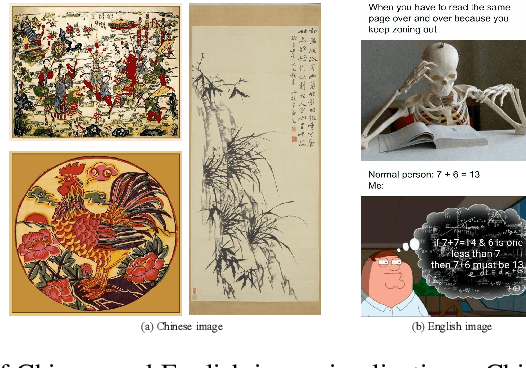
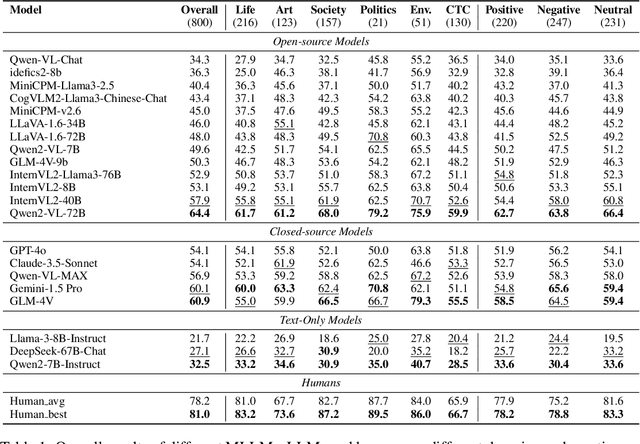
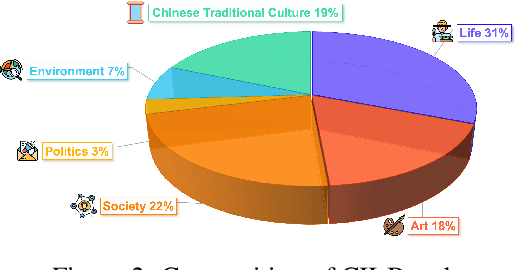
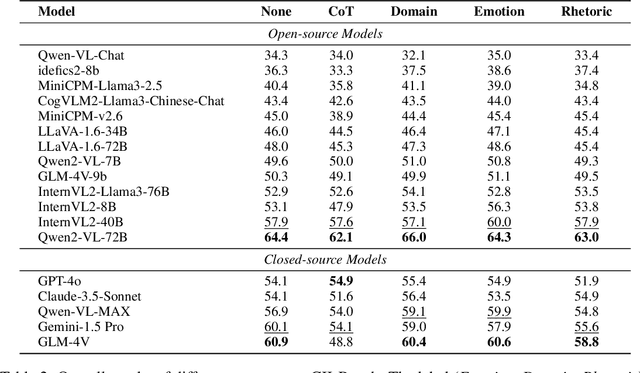
Abstract:As the capabilities of Multimodal Large Language Models (MLLMs) continue to improve, the need for higher-order capability evaluation of MLLMs is increasing. However, there is a lack of work evaluating MLLM for higher-order perception and understanding of Chinese visual content. To fill the gap, we introduce the **C**hinese **I**mage **I**mplication understanding **Bench**mark, **CII-Bench**, which aims to assess the higher-order perception and understanding capabilities of MLLMs for Chinese images. CII-Bench stands out in several ways compared to existing benchmarks. Firstly, to ensure the authenticity of the Chinese context, images in CII-Bench are sourced from the Chinese Internet and manually reviewed, with corresponding answers also manually crafted. Additionally, CII-Bench incorporates images that represent Chinese traditional culture, such as famous Chinese traditional paintings, which can deeply reflect the model's understanding of Chinese traditional culture. Through extensive experiments on CII-Bench across multiple MLLMs, we have made significant findings. Initially, a substantial gap is observed between the performance of MLLMs and humans on CII-Bench. The highest accuracy of MLLMs attains 64.4%, where as human accuracy averages 78.2%, peaking at an impressive 81.0%. Subsequently, MLLMs perform worse on Chinese traditional culture images, suggesting limitations in their ability to understand high-level semantics and lack a deep knowledge base of Chinese traditional culture. Finally, it is observed that most models exhibit enhanced accuracy when image emotion hints are incorporated into the prompts. We believe that CII-Bench will enable MLLMs to gain a better understanding of Chinese semantics and Chinese-specific images, advancing the journey towards expert artificial general intelligence (AGI). Our project is publicly available at https://cii-bench.github.io/.
LIME-M: Less Is More for Evaluation of MLLMs
Sep 10, 2024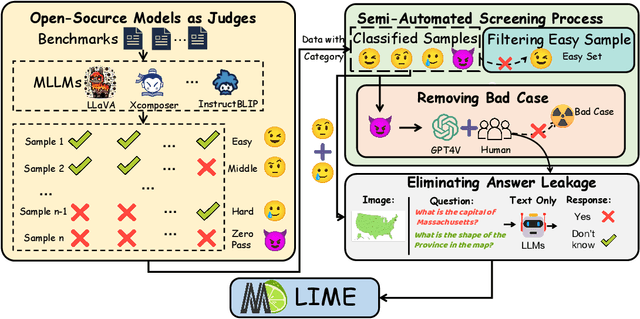
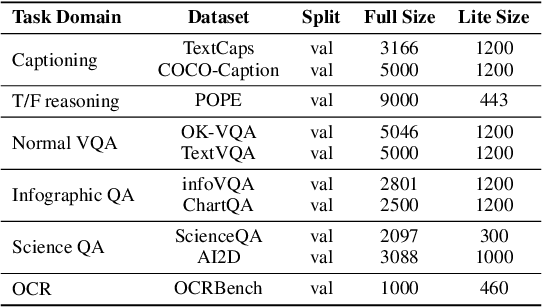
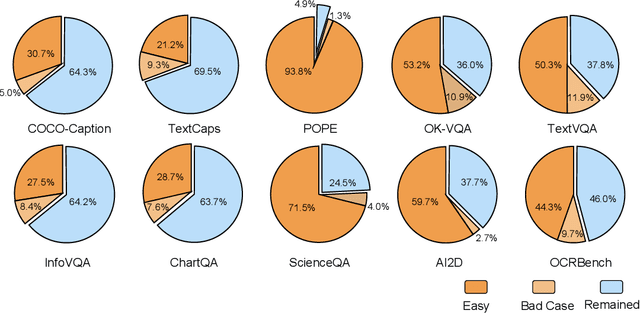
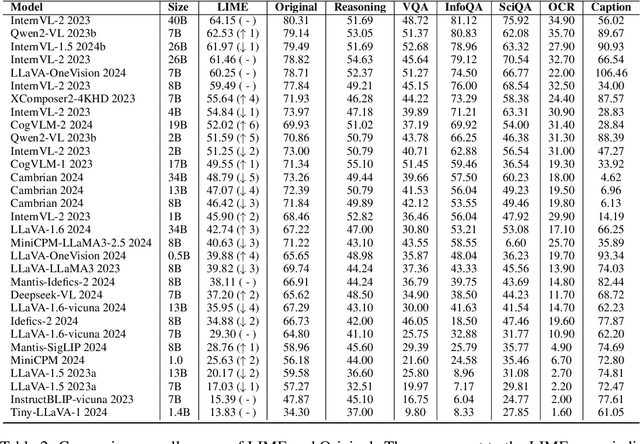
Abstract:With the remarkable success achieved by Multimodal Large Language Models (MLLMs), numerous benchmarks have been designed to assess MLLMs' ability to guide their development in image perception tasks (e.g., image captioning and visual question answering). However, the existence of numerous benchmarks results in a substantial computational burden when evaluating model performance across all of them. Moreover, these benchmarks contain many overly simple problems or challenging samples, which do not effectively differentiate the capabilities among various MLLMs. To address these challenges, we propose a pipeline to process the existing benchmarks, which consists of two modules: (1) Semi-Automated Screening Process and (2) Eliminating Answer Leakage. The Semi-Automated Screening Process filters out samples that cannot distinguish the model's capabilities by synthesizing various MLLMs and manually evaluating them. The Eliminate Answer Leakage module filters samples whose answers can be inferred without images. Finally, we curate the LIME-M: Less Is More for Evaluation of Multimodal LLMs, a lightweight Multimodal benchmark that can more effectively evaluate the performance of different models. Our experiments demonstrate that: LIME-M can better distinguish the performance of different MLLMs with fewer samples (24% of the original) and reduced time (23% of the original); LIME-M eliminates answer leakage, focusing mainly on the information within images; The current automatic metric (i.e., CIDEr) is insufficient for evaluating MLLMs' capabilities in captioning. Moreover, removing the caption task score when calculating the overall score provides a more accurate reflection of model performance differences. All our codes and data are released at https://github.com/kangreen0210/LIME-M.
Lower Layer Matters: Alleviating Hallucination via Multi-Layer Fusion Contrastive Decoding with Truthfulness Refocused
Aug 16, 2024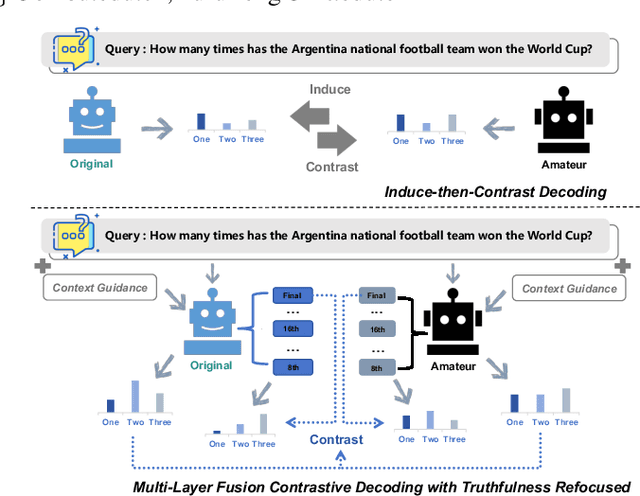
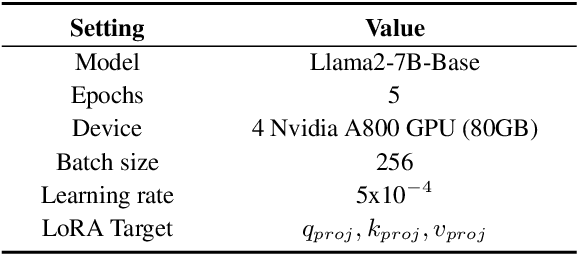
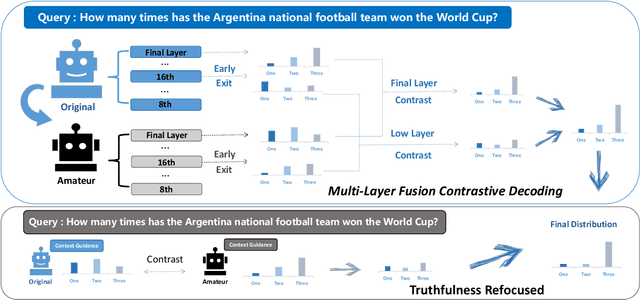
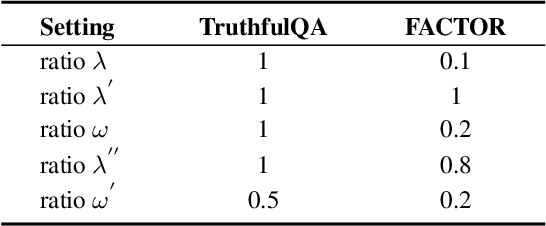
Abstract:Large Language Models (LLMs) have demonstrated exceptional performance across various natural language processing tasks, yet they occasionally tend to yield content that factually inaccurate or discordant with the expected output, a phenomenon empirically referred to as "hallucination". To tackle this issue, recent works have investigated contrastive decoding between the original model and an amateur model with induced hallucination, which has shown promising results. Nonetheless, this method may undermine the output distribution of the original LLM caused by its coarse contrast and simplistic subtraction operation, potentially leading to errors in certain cases. In this paper, we introduce a novel contrastive decoding framework termed LOL (LOwer Layer Matters). Our approach involves concatenating the contrastive decoding of both the final and lower layers between the original model and the amateur model, thereby achieving multi-layer fusion to aid in the mitigation of hallucination. Additionally, we incorporate a truthfulness refocused module that leverages contextual guidance to enhance factual encoding, further capturing truthfulness during contrastive decoding. Extensive experiments conducted on two publicly available datasets illustrate that our proposed LOL framework can substantially alleviate hallucination while surpassing existing baselines in most cases. Compared with the best baseline, we improve by average 4.5 points on all metrics of TruthfulQA. The source code is coming soon.
DeliLaw: A Chinese Legal Counselling System Based on a Large Language Model
Aug 01, 2024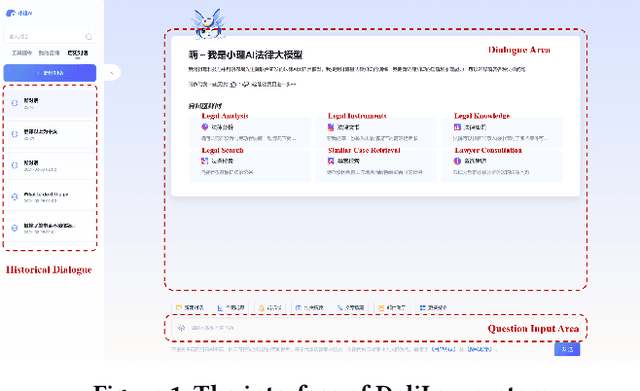
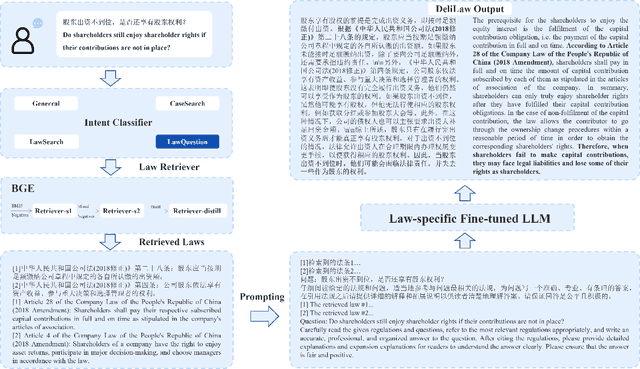
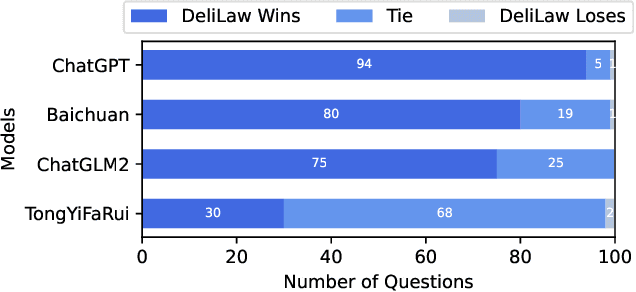
Abstract:Traditional legal retrieval systems designed to retrieve legal documents, statutes, precedents, and other legal information are unable to give satisfactory answers due to lack of semantic understanding of specific questions. Large Language Models (LLMs) have achieved excellent results in a variety of natural language processing tasks, which inspired us that we train a LLM in the legal domain to help legal retrieval. However, in the Chinese legal domain, due to the complexity of legal questions and the rigour of legal articles, there is no legal large model with satisfactory practical application yet. In this paper, we present DeliLaw, a Chinese legal counselling system based on a large language model. DeliLaw integrates a legal retrieval module and a case retrieval module to overcome the model hallucination. Users can consult professional legal questions, search for legal articles and relevant judgement cases, etc. on the DeliLaw system in a dialogue mode. In addition, DeliLaw supports the use of English for counseling. we provide the address of the system: https://data.delilegal.com/lawQuestion.
II-Bench: An Image Implication Understanding Benchmark for Multimodal Large Language Models
Jun 11, 2024



Abstract:The rapid advancements in the development of multimodal large language models (MLLMs) have consistently led to new breakthroughs on various benchmarks. In response, numerous challenging and comprehensive benchmarks have been proposed to more accurately assess the capabilities of MLLMs. However, there is a dearth of exploration of the higher-order perceptual capabilities of MLLMs. To fill this gap, we propose the Image Implication understanding Benchmark, II-Bench, which aims to evaluate the model's higher-order perception of images. Through extensive experiments on II-Bench across multiple MLLMs, we have made significant findings. Initially, a substantial gap is observed between the performance of MLLMs and humans on II-Bench. The pinnacle accuracy of MLLMs attains 74.8%, whereas human accuracy averages 90%, peaking at an impressive 98%. Subsequently, MLLMs perform worse on abstract and complex images, suggesting limitations in their ability to understand high-level semantics and capture image details. Finally, it is observed that most models exhibit enhanced accuracy when image sentiment polarity hints are incorporated into the prompts. This observation underscores a notable deficiency in their inherent understanding of image sentiment. We believe that II-Bench will inspire the community to develop the next generation of MLLMs, advancing the journey towards expert artificial general intelligence (AGI). II-Bench is publicly available at https://huggingface.co/datasets/m-a-p/II-Bench.
Enhancing Noise Robustness of Retrieval-Augmented Language Models with Adaptive Adversarial Training
May 31, 2024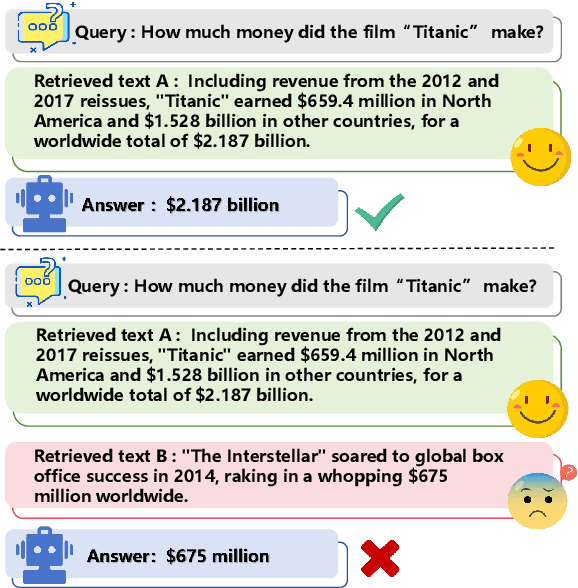
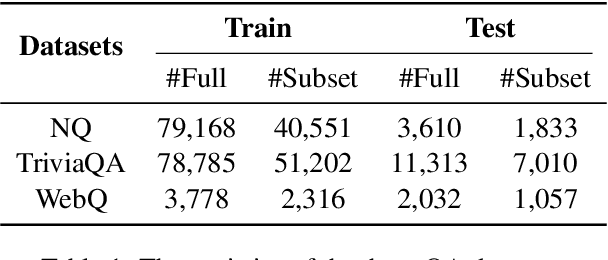

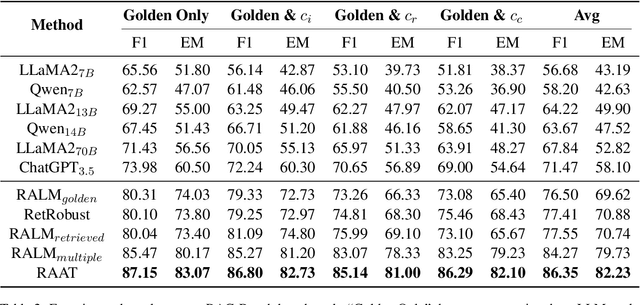
Abstract:Large Language Models (LLMs) exhibit substantial capabilities yet encounter challenges, including hallucination, outdated knowledge, and untraceable reasoning processes. Retrieval-augmented generation (RAG) has emerged as a promising solution, integrating knowledge from external databases to mitigate these challenges. However, inappropriate retrieved passages can potentially hinder the LLMs' capacity to generate comprehensive and high-quality responses. Prior RAG studies on the robustness of retrieval noises often confine themselves to a limited set of noise types, deviating from real-world retrieval environments and limiting practical applicability. In this study, we initially investigate retrieval noises and categorize them into three distinct types, reflecting real-world environments. We analyze the impact of these various retrieval noises on the robustness of LLMs. Subsequently, we propose a novel RAG approach known as Retrieval-augmented Adaptive Adversarial Training (RAAT). RAAT leverages adaptive adversarial training to dynamically adjust the model's training process in response to retrieval noises. Concurrently, it employs multi-task learning to ensure the model's capacity to internally recognize noisy contexts. Extensive experiments demonstrate that the LLaMA-2 7B model trained using RAAT exhibits significant improvements in F1 and EM scores under diverse noise conditions. For reproducibility, we release our code and data at: https://github.com/calubkk/RAAT.
CLHA: A Simple yet Effective Contrastive Learning Framework for Human Alignment
Mar 26, 2024Abstract:Reinforcement learning from human feedback (RLHF) is a crucial technique in aligning large language models (LLMs) with human preferences, ensuring these LLMs behave in beneficial and comprehensible ways to users. However, a longstanding challenge in human alignment techniques based on reinforcement learning lies in their inherent complexity and difficulty in training. To address this challenge, we present a simple yet effective Contrastive Learning Framework for Human Alignment (CLHA) to align LLMs with human preferences directly. CLHA employs a novel rescoring strategy to evaluate the noise within the data by considering its inherent quality and dynamically adjusting the training process. Simultaneously, CLHA utilizes pairwise contrastive loss and adaptive supervised fine-tuning loss to adaptively modify the likelihood of generating responses, ensuring enhanced alignment with human preferences. Using advanced methods, CLHA surpasses other algorithms, showcasing superior performance in terms of reward model scores, automatic evaluations, and human assessments on the widely used ``Helpful and Harmless'' dataset.
 Add to Chrome
Add to Chrome Add to Firefox
Add to Firefox Add to Edge
Add to Edge